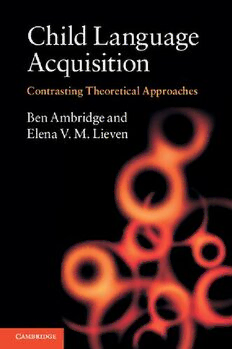
Child Language Acquisition: Contrasting Theoretical Approaches PDF
Preview Child Language Acquisition: Contrasting Theoretical Approaches
ChildLanguageAcquisition ContrastingTheoreticalApproaches Is children’s language acquisition based on innate linguistic structures or built from cognitive and communicative skills? This book summarizes the majortheoreticaldebatesinallofthecoredomainsofchildlanguageacquisi- tionresearch(phonology,wordlearning,inflectionalmorphology,syntaxand binding)andincludesacompleteintroductiontothetwomajorcontrasting theoretical approaches: generativist and constructivist. For each debate, the predictionsofthecompetingaccountsarecloselyandeven-handedlyevalu- atedagainsttheempiricaldata.Theresultisanevidence-basedreviewofthe centralissuesinlanguageacquisitionresearchthatwillconstituteavaluable resourceforstudents,teachers,course-buildersandresearchersalike. ben ambridge is Lecturer in Psychology at the University of Liverpool. He has published numerous articles on child language acquisition with a particularfocusontheacquisitionofsyntaxandmorphology,andtheretreat fromovergeneralizationerror. elena v. m. lievenisProfessorandSeniorResearcherattheMaxPlanck Institute for Evolutionary Anthropology, Leipzig, and Director of the Max PlanckChildStudyCentre,UniversityofManchester.Sheisbestknownfor herworkonnaturalisticcorpusdata,andisaformereditoroftheJournalof ChildLanguage. Child Language Acquisition Contrasting Theoretical Approaches BenAmbridge ElenaV.M.Lieven cambridgeuniversitypress Cambridge,NewYork,Melbourne,Madrid,CapeTown, Singapore,Sa˜oPaulo,Delhi,Tokyo,MexicoCity CambridgeUniversityPress TheEdinburghBuilding,CambridgeCB28RU,UK PublishedintheUnitedStatesofAmericabyCambridgeUniversityPress,NewYork www.cambridge.org Informationonthistitle:www.cambridge.org/9780521745239 (cid:1)c BenAmbridgeandElenaV.M.Lieven2011 Thispublicationisincopyright.Subjecttostatutoryexception andtotheprovisionsofrelevantcollectivelicensingagreements, noreproductionofanypartmaytakeplacewithoutthewritten permissionofCambridgeUniversityPress. Firstpublished2011 PrintedintheUnitedKingdomattheUniversityPress,Cambridge AcataloguerecordforthispublicationisavailablefromtheBritishLibrary LibraryofCongressCataloguinginPublicationdata Ambridge,Ben,1977– Childlanguageacquisition:contrastingtheoreticalapproaches/BenAmbridge, ElenaV.M.Lieven. p. cm. Includesbibliographicalreferencesandindex. ISBN978-0-521-76804-7(hardback) 1.Children–Language. 2.Languageacquisition. 3.Languagearts(Early childhood) 4.Verbalabilityinchildren. I.Lieven,ElenaV.M. II.Title. P118.A47 2011 401′.41–dc22 2010048067 ISBN978-0-521-76804-7Hardback ISBN978-0-521-74523-9Paperback CambridgeUniversityPresshasnoresponsibilityforthepersistenceor accuracyofURLsforexternalorthird-partyinternetwebsitesreferredto inthispublication,anddoesnotguaranteethatanycontentonsuch websitesis,orwillremain,accurateorappropriate. Contents Listoffigures pagevii Listoftables x Listofboxes xi Listofsummarytables xii Preface xiii Acknowledgements xv 1 Introduction 1 1.1 Themajortheoreticalapproaches 1 1.2 Thedomainsanddebates 4 1.3 Methodologies 6 2 Speechperception,segmentationandproduction 13 2.1 Introduction 13 2.2 Characteristicsofspeech 14 2.3 Developingaphonemicinventory 18 2.4 Segmentingthespeechstreamintowords,phrasesandclauses 31 2.5 Speechproduction 47 2.6 Speechperception,segmentationandproduction:conclusion 57 3 Learningwordmeanings 61 3.1 Introduction 61 3.2 Theconstraintsor‘principles’approach 62 3.3 Thesocial-pragmaticapproach 70 3.4 Theassociativelearningapproach 83 3.5 Syntacticbootstrapping 89 3.6 Conclusion:howdochildrenlearnthemeaningsofwords? 100 4 Theoreticalapproachestogrammaracquisition 103 4.1 Generativistapproaches 103 4.2 Constructivistapproaches 123 4.3 Theoreticalapproachestogrammaracquisition:conclusion 136 5 Inflection 137 5.1 Introductiontoinflection 137 v vi Contents 5.2 Whydochildrenfailtomarktenseandagreementinobligatory contexts? 144 5.3 Arechildrenlessproductivewithmorphologythanadults? 157 5.4 Rulesversusanalogiesininflectionalmorphology(withspecial referencetotheEnglishpast-tensedebate) 169 5.5 Learninginflectionalmorphology:conclusion 187 6 Simplesyntax 191 6.1 Identifying/constructingsyntacticcategories 192 6.2 Acquiringbasicwordorder 209 6.3 Theretreatfromovergeneralizationerror 242 6.4 Simplesyntax:conclusion 265 7 Movementandcomplexsyntax 269 7.1 Non-canonicalwordorders(passivesandquestions) 269 7.2 Multiple-clausesentences 289 7.3 Movementandcomplexsyntax:conclusion 312 8 Binding,quantificationandcontrol 314 8.1 Bindingandcoreference 315 8.2 Quantification 335 8.3 Control 346 8.4 Binding,quantificationandcontrol:conclusion 357 9 Relateddebatesandconclusions 359 9.1 Relateddebates 359 9.2 Conclusionsandfuturedirections 369 Notes 377 References 387 Authorindex 427 Subjectindex 432 Figures 2.1 AsoundspectrogramoftheutteranceTherearereallyalot ofwordstolearn(redrawnfromPeterW.Jusczyk,The DiscoveryofSpokenLanguage,figure1.1.(cid:1)C 1997 MassachusettsInstituteofTechnology,bypermissionofthe MITPress) page15 2.2 Schematizedsoundspectrogramsofsyllablesofthevoiced stopconsonants[b],[d]and[g]beforesevendifferent Englishvowels(fromJusczyk,1997;reproducedby permissionoftheMITPress) 16 2.3 Schematicspectrogramsofthesyllables[pi],[ka]and[pu] (fromJusczyk,1997;reproducedbypermissionoftheMIT Press) 17 3.1 AnexampletrialfromNaigles(1990)forachildinthe transitive-audiocondition.Stimulifromamodified replicationofthisstudyconductedbyNoble,Rowlandand Pine(inpress;reproducedbypermissionoftheauthors) 92 4.1 Asimplephrase-structuretree 106 4.2 Asimplephrase-structuretreeforthestringtheboy 106 4.3 ANOUNPHRASEcanbeofanylength 106 4.4 AsimpleNPorVPconsistsofasingleNOUNorVERB 107 4.5 Thethree-levelstructureofVP:V′containsthehead(V) anditscomplement(anNP) 107 4.6 ExpandingV′tohouseanadjunct 108 4.7 Foreverycategory,theheadcombineswithanycomplement toformasingle-barphrase 109 4.8 Initialstructureofasimpletransitivesentence 109 4.9 TheverbmovesfromVtoItoreceiveinflection 111 4.10 ThesubjectmovestoSpecIPtochecknominativecase (e.g.he/∗him) 112 4.11 Auxiliaries(e.g.will)aredirectlygeneratedatI(Johnwill kickSue) 113 4.12 VerbAgreementischeckedatI 113 vii viii Listoffigures 4.13 IPissplitintoAGRPandTNSP 114 4.14a Structureofacomplementclause 115 4.14b All‘sentences’areCPs 115 4.15 Yes/noquestionsareformedfromdeclarativesbymovement oftheauxiliary 116 4.16 Illegalmovement‘outside’thephrasestructuretree 116 4.17 CPprovidesalandingsiteforsubject–auxiliaryinversionin questions 117 4.18 SentenceswithacomplementclausecontaintwonestedCPs 117 4.19 Ataxonomichierarchyofconstructions 130 4.20 Generativistandconstructivistanalysisaresometimes (apparent)notationalvariants 132 5.1 Actual(left-handpanel)andpredicted(right-handpanel) ratesofRIerrors(‘non-finites’;e.g.Hego),correctsimple finites(e.g.Hegoes)andcompoundfinites(e.g.Heisgoing) fortheEnglishandDutchchildrenstudiedbyFreudenthal etal.(2007:326;reproducedbypermissionoftheCognitive ScienceSociety) 154 6.1 Meanproportionofutterancesforwhichchildrenmatched theexperimenter’sweirdwordorder(SOV/VSO)or–ina controlcondition–conventionalSVOword-order(from Akhtar,1999:346;reproducedbypermissionofCambridge UniversityPress) 224 7.1 FormationofthepassivesentenceTheballwaskickedunder agenerativistaccount 271 7.2 Unergativeandunaccusativeintransitiveverbs 272 7.3 Generativistanalysisofwh-questions 282 7.4 Wh-movementinsubject(left)andobject(right)relative clauses 292 8.1 Bc-commandsD,EandF;Dc-commandsB;EandF c-commandoneanother 315 8.2 PrincipleAgovernsinterpretationofGoldilocks saidthat i MamaBear istouchingherself 318 j ∗i/j 8.3 PrincipleA:proportionofcorrectresponses(‘no’)tothe questions‘IsMamaBeartouchingherself’(left-handpanel) and‘Iseverybeartouchingherself?’(right-handpanel) (fromChienandWexler,1990:269;reproducedby permissionofTaylor&Francis) 319 8.4 PrincipleBgovernsinterpretationofMamaBear is j touchingher 320 ∗j 8.5 PrincipleB.Proportionofcorrectresponses(‘no’)tothe questions‘IsMamaBeartouchingher’(left-handpanel)and
